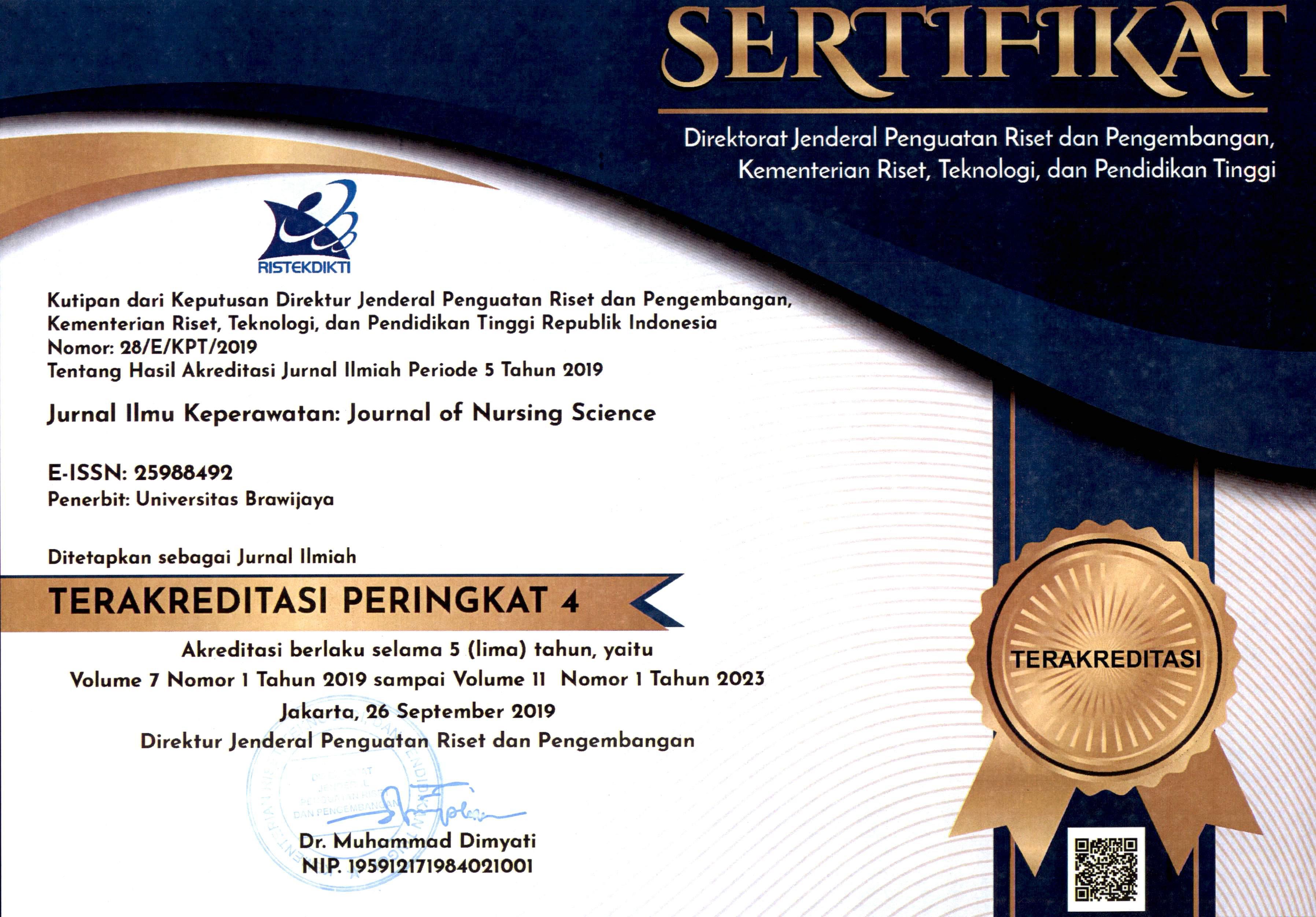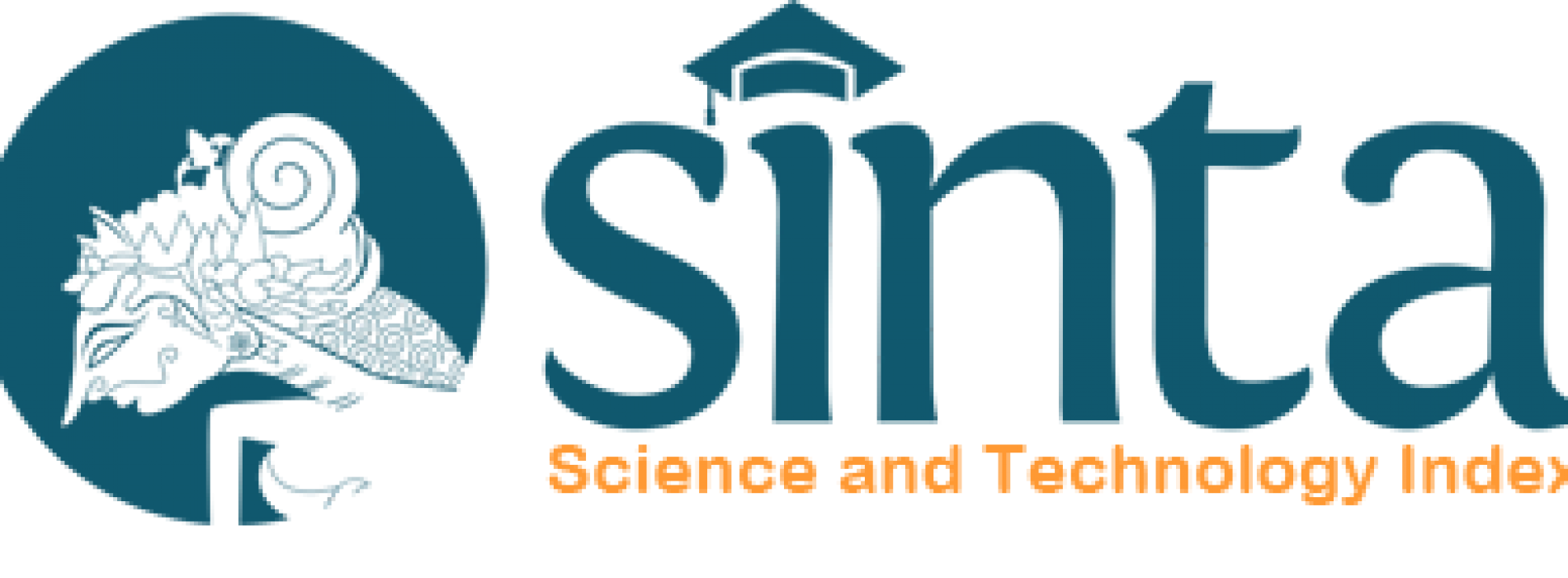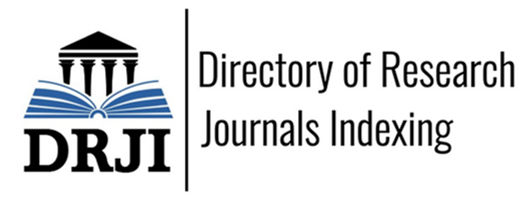SOCIAL SUPPORT RECEIVED BY SUBSTANCE ABUSER IN SLEMAN REGENCY
DOI:
https://doi.org/10.21776/ub.jik.2020.008.01.7Keywords:
Drug Abuse, Social Support, RecoveryAbstract
province has the highest prevalence of substance abuse among students in Indonesia.
Substance abuse has negative impacts on health, both physically and psychologically.
Because of that, recovery is needed to restore the function and role of the individual.
When they undergo the recovery process, social support is required. This study aimed
to determine the meaning of experience in undergoing the process of recovery of
substance dependence during receiving social support. This study used qualitative
with interpretative phenomenology design. Participants were taken using purposive
sampling method, there were 9 participants included in this study. The data retrieval
technique through in-depth interviews with an open-ended question. The data analysis
used was Interpretative Phenomenological Analysis (IPA) method. Based on the results,
themes were obtained: (1) Understanding recovery is a long life process; (2) Receiving
a whip which saves you from the downturn; (3) Not being a part of the world of life; (4)
Gain a sense of humanity in society; (5) Gain the whole support to rise from adversity.
The result showed that the support was interpreted as a lash, meaning that it could give
uncomfortable feelings, such as forced to change, received too much advice, or negative
comments. However, it also could increase the motivation to move forward for the clients.
Finally, researchers suggest further research to explore the relation of social support and
gender issues when they underwent substance recovery.
References
- Aztri & Milla. (2013). Rasa Berharga dan Pelajaran Hidup Mencegah Kekambuhan Kembali Pada Klien ketergantungan Narkoba Studi Kualitatif Fenomenologis. Jurnal Psikologi. Volume 9, Nomor 1, Juni
- Badri M. (2013). Implementasi Undang-Undang No. 35 Tahun 2009 Tentang Narkotika Dalam Pelaksanaan Wajib Lapor Bagi Pecandu Narkotika. Jurnal
- Ilmiah Universitas Batanghari Jambi, 13 (3): 7-12.
- Betty, T., & Panel, C. (2007). What is recovery? A working definition from the Betty Ford Institute. Journal of Substance Abuse Treatment, 33(3), 221–228. https://doi.org/10.1016/j.jsat.2007.06.001
- BNN & Pusat Penelitian Kesehatan Universitas Indonesia. (2016). Hasil Survei Penyalahgunaan dan Peredaran Gelap Narkoba Pada Kelompok Pelajar dan Mahasiswa di 18 Provinsi Tahun 2016. Jakarta
- Chambers, A. S. E., Canvin, K., David, S., & Sinclair, J. M. A. (2017). Identity in recovery from problematic alcohol Use: A qualitative study of online mutual aid. Drug and Alcohol Dependence. https://doi.org/10.1016/j.drugalcdep.2017.01.009
- Choate, P. W., & Doan, A. (2015). Adolescent Alcoholism and Drug Addiction: The Experience of Parents. Behav. Sci. Behav. Sci, 5(5), 461–476. https://doi.org/10.3390/bs5040461
- Dennis & Scott. (2007). Managing addisction as a chronic condition. Addiction Science & Clinical Practice
- Dinos, Stevens, Serfaty, Weich, & King. (2004). Stigma: the feelings and experiences of 46 people with mental illness. British Journal of Psychiatric (2004). 184. 176 – 181
- Fisher, K., Manoogian, M. M., & Hoover, S. (2016). “ Drugs was My Solution -- My Problem was Life â€: Heroin Addiction and the Life Course Perspective “ Drugs was My Solution -- My Problem was Life â€: Heroin Addiction and, 5.
- Fredericks, J., & Samuel, E. (2014). Drugs and Recovery: A Qualitative Study in Atlantic Canada. Aijssnet.Com, 3(2), 28–34. Retrieved from http://www.aijssnet.com/journals/Vol_3_No_2_March_2014/4.pdf
- Ghouchani, H. T., Niknami, S., Aminshokravi, F., & Hojjat, S. K. (2015). Social Support : The Main Factor for Retention of Addiction Treatment,.
- Gueta, K., & Addad, M. (2015). Women â€TM s Studies International Forum A house of cards : The long-term recovery experience of former drug-dependent Israeli women ☆ , ☆☆. Women’s Studies International Forum, 48, 18–28. https://doi.org/10.1016/j.wsif.2014.10.003.
- Handayani. (2011). Pengaruh keluarga, masyarakat dan pendidikan terhadap pencegahan bahaya narkoba di kalangan remaja. Universitas Indonesia
- Hiller, S. P., A, M. P. I., Syvertsen, J. L., H, M. P., Lozada, R., D, M., … H, M. P. (2013). Journal of Substance Abuse Treatment Social support and recovery among Mexican female sex workers who inject drugs. Journal of Substance Abuse Treatment, 45(1), 44–54. https://doi.org/10.1016/j.jsat.2012.12.009
- Korkiamaki, Riikkaa. (2014). Rethinking loneliness – a qualitative study about adolescents’ experiences of being an outsider in peer group. Open Journal of Depression. 2014, 3, 125 – 135
- Krisnawati & Utami. (2014). Pelaksanaan Rehabilitasi Bagi Pecandu Narkotika Pasca Berlakunya Peraturan Bersama 7 (Tujuh) Lembaga Negara Republik Indonesia. Fakultas Hukum Universitas Gadjah Mada.
- Laudet, A. B., Savage, R., & Mahmood, D. (2002). Pathways to long-term recovery: A preliminary investigation. J Psychoactive Drugs, 34(3), 305–311. https://doi.org/10.1038/jid.2014.371
- Maslim. (2013). Diagnosis Gangguan Jiwa, Rujukan Ringkas PPDGJ-III dan DSM-V. Bagian Ilmu Kedokteran Jiwa FK Unika Atma Jaya. Jakarta
- Nawafilaty, Tawaduddin. (2015). Persepsi terhadap keharmonisan keluarga, self disclosure dan deliquency remaja. Persona, Jurnal Psikologi Indonesia. Vol. 4, No. 2, hal. 175 – 182
- National Institute on Drug Abuse. (2004). Physical and Psychological Effects of Substance Use. U.S Department Of Health And Human Services. Maryland.
- Nelson, J. A., Henriksen, R. C., & Keathley, R. S. (2014). Mothers of Sons with Substance Use Disorders : A Grounded Theory Approach Revealing Maternal Expectations and Three Stages of Change, 19(2010), 1–16.
- Nurjanisah, Tahlil, & Hasballah. (2017). Analisis Penyalahgunaan NAPZA dengan Pendekatan Health Belief Model. Jurnal Ilmu Keperawatan. Vol 5, No. 1, 2017 ISSN: 2338-6371
- Pantridge, C., Charles, V., DeHart, D., Lachini, A., Seay, K. D., Clone, S., & Browne, T. (2016). A Qualitative Study of the Role of Peer Support Specialists in Substance Use Disorder Treatment: Examining the Types of Support Provided. Alcoholism Treatment Quarterly, 34(3), 337–353. https://doi.org/10.1080/07347324.2016.1182815
- Park & Park. (2014). Family stigma: a consept analysis. Asian Nursing Research. 8 (2014) 165 – 171
- Purba, Wahyuni, Nasution, & Daulay. (2008). Asuhan Keperawatan Pada Klien Dengan Masalah Psikososial dan Gangguan Jiwa. Medan: USU Press
- Reif, S., Braude, L., Lyman, D. R., Dougherty, R. H., Daniels, A. S., Ghose, S. S., … Delphin-Rittmon, M. E. (2014). Peer Recovery Support for Individuals With Substance Use Disorders: Assessing the Evidence. Psychiatric Services (Washington, D.C.), 65(7), 853–861. https://doi.org/10.1176/appi.ps.201400047
- Sarafino & Smith. (2011). Health Psychology: Biopsychosocial Interactions. Ed.7th. Wiley John Wiley & Sons, Inc.
- Saltz, Larson, LaBelle, Richards, & Samet. (2008). The case for chronic management for addiction. National Institute of Health. J Addict Med. June 1; 2 (2)
- Sleman. (2010). Prasarana dan Sarana. Diunduh di https://www.slemankab.go.id/210/prasarana-dan-sarana.slm. Pada Pada 17 Juni 2017
- Sulistami, Yulia, & Tegawati. (2013). Bahaya NAPZA. Jakarta: PT. Mustika Cendekia Negeri
- Sarafino & Smith. (2011). Health Psychology: Biopsychosocial Interactions. Ed.7th. Wiley John Wiley & Sons, Inc.
- UNODCb. (2016). World Drugs Report 2016 — Executive Summary. UNODC Research
- United Nation On Drug and Crime (UNODC). (2013). World Drug Report 2013. Bangkok, Thailand
Downloads
Published
How to Cite
License
Authors published in this journal agree to the following terms:
1. The copyright of the received article shall be assigned to the journal as the publisher of the journal. The intended copyright includes the right to publish the article in various forms (including reprints). The journal maintains the publishing rights to the published articles.
2. Authors may enter into separate additional contractual agreements for the non-exclusive distribution of the published journal version of the work (for example, posting it to an institutional repository or publishing it in a book), with acknowledgment of their initial publication in this journal.
3. Authors are permitted and encouraged to post their work online (e.g. in an Institutional Repository or on their website) before and during the submission process, as this can result in a productive exchange, as well as earlier and larger citations of the published work.
4. Articles and all related material published are distributed under Creative Commons Attribution-NonCommercial 4.0 International License or CC BY-NC 4.0 license.
JNSU is licensed under a Creative Commons Attribution-NonCommercial 4.0 International License or CC BY-NC 4.0 license.
Most read articles by the same author(s)
- Bintari Ratih Kusumaningrum, Indah Winarni, Setyoadi Setyoadi, Kumboyono Kumboyono, Retty Ratnawati, PENGALAMAN PERAWAT UNIT GAWAT DARURAT (UGD) PUSKESMAS DALAM MERAWAT KORBAN KECELAKAAN LALU LINTAS , Journal of Nursing Science Update (JNSU): Vol. 1 No. 2 (2013)
- Athi' Linda Yani, Indah Winarni, Retno Lestari, EKSPLORASI FENOMENA KORBAN BULLYING PADA KESEHATAN JIWA REMAJA DI PESANTREN , Journal of Nursing Science Update (JNSU): Vol. 4 No. 2 (2016)
- Iva Milia Hani Rahmawati, Retty Ratnawati, Septi Dewi Rachmawati, PENGALAMAN PERAWAT DALAM MEMBERIKAN LAYANAN KEPERAWATAN JIWA PADA PECANDU NAPZA DI PUSAT REHABILITASI BADAN NARKOTIKA NASIONAL KARESIDENAN KEDIRI , Journal of Nursing Science Update (JNSU): Vol. 4 No. 2 (2016)
- Zidni Nuris Yuhbaba, Indah Winarni, Retno Lestari, STUDI FENOMENOLOGI: POST TRAUMATIC GROWTH PADA ORANG TUA ANAK PENDERITA KANKER , Journal of Nursing Science Update (JNSU): Vol. 5 No. 1 (2017)
- Wenny Nugrahati Carsita, Indah Winarni, Retno Lestari, STUDI FENOMENOLOGI: ORANG DENGAN HIV AIDS (ODHA) DALAM MENJALANI SELF-DISCLOSURE DI WILAYAH KERJA PUSKESMAS BONGAS , Journal of Nursing Science Update (JNSU): Vol. 4 No. 2 (2016)
- Septi Dewi Rachmawati, PENGARUH BUAH MAHKOTA DEWA TERHADAP KADAR KOLESTEROL TOTAL PLASMA PADA TIKUS STRAIN WISTAR , Journal of Nursing Science Update (JNSU): Vol. 1 No. 1 (2013)
- Abd Nasir, Indah Winarni, Retno Lestari, THE EXPERIENCE OF SHADOW TEACHERS IN HELPING CHILDREN WTH SPECIAL NEEDS IN TELOGO PATUT ELEMENTARY SCHOOL I GRESIK , Journal of Nursing Science Update (JNSU): Vol. 6 No. 1 (2018)
- Rita Rinjani Mekka, Retty Ratnawati, Septi Dewi Rachmawati, STUDI FENOMENOLOGI : PENGALAMAN PERAWAT TERKAIT KETIDAKBERHASILAN RESUSITASI PADA NEONATAL DENGAN ASFIKSIA DI RUANG NEONATUS RSUD DR. R. SOEDJONO SELONG LOMBOK TIMUR , Journal of Nursing Science Update (JNSU): Vol. 4 No. 2 (2016)
- I Nengah Dartha Yasa, Indah Winarni, Retno Lestari, PENGALAMAN TENAGA KERJA INDONESIA (TKI) YANG MENGALAMI ABUSE , Journal of Nursing Science Update (JNSU): Vol. 4 No. 2 (2016)
- Atin Humayya, Heni Dwi Windarwati, Indah Winarni, Behavior Therapy in Those Who Are Addicted to Online Games , Journal of Nursing Science Update (JNSU): Vol. 10 No. 1 (2022): May





























